

 |
Nothing much happening at Panmunjom. Last bits of snow melting. We were told the 'Americans' are all in the building keeping out of sight. (Certainly warmer inside so I'm not surprised!) A Pakistani military man in full uniform was visiting a few minutes behind us. I thought it a bit in-the-face that he was in uniform and not civilian clothes. The South Korean guards photograph (and scowl) at all visitors through the windows. I am told that the north Koreans scowl at south Korean visitors. I must find out one day and visit from the other side. Photography was permitted everywhere, we did not have to sign anything to visit and as you can see denim jeans are permitted. I am told all this is contrary to visits from the South Korean side. We were given no instruction about what to do or what not to do with the single exception of not crossing a white line near the entrance doors to the huts which you can see in the photo. (This comes from the the 1984 defection of a russian woman and the shoot-out which occurred. (The DPRK version of that event (that it was a tourist backing backwards too far to take a photo and backed into south Korea by accident) is slightly different to the western version!) February 7, 2003. |
Doing a google on 'panmunjom' and reading visitor accounts from the south Korean side one is stuck by the greater hype which seems to be instilled into visitors on that side: signing waiver forms, don't take photographs, don't gesture at the DPRK soldiers, etc. For example, read this account. Well in my two visits I can only say I found slightly bored soldiers who were friendly and just like normal soldiers anywhere stationed on a boring border where nothing ever happens. It was the south korean guards and (back in 5/2002) the Americans who were scowling and slightly aggressive. Now it well may be that the DPRK soldiers are the same to south Korean visitors. But certainly there were no obvious armed soldiers in the building immediately behind the huts (they were just sitting playing cards) nor anywhere else I could see. Of course, I can understand the desire by the USA and south Koreans to demonize the otherside but these soldiers are just as much victims of Kim Jn. as the citizens in the whole DPRK. Trips from the southern side refer to a Potempkin village in the north of the DMZ. Frankly, I think this is just more demonization (and a lack of understanding of the origin of the term.) Accounts mention the lack of windows in this village. Well many of the buildings in Kaesong also lack glass windows and were covered in plastic sheeting (as in Pyongyang too.)
 |
In the DMZ at the United Nation Hall where the 1953 cease-fire negotiations were held. Many photos and items from the Korean War and subsequent clashes were in the museum here. In particular 'the' axe from the 1976 clash over chopping down a tree. Soldiers on both sides were killed. (Needless to say the account of the incident given by the DPRK soldiers was also slightly different from the South Korean/American version. Also here and most recently here.) Note the very well fed soldier, his top quality clothes but he is not that tall. The DPRK army has had to reduce the minimum height for recruits since there is not enough food to feed people. The 'Army-first' is official policy this year. Away from Panmunjom the DPRK soldiers were friendly, smiled and were quite natural. There was never a hint of animosity towards me as a westerner but then they knew I could not be American since Americans are not admitted to the DPRK. February 7, 2003. |
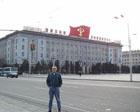 |
Victory Square where Marx and Lenin are alive and well. Note the dots on the ground so the masses can position themselves for the big displays using flash-cards and lights. |
On the same flight as me going to Pyongyang was The Guardian journalist Jon Watts. You can read his excelent audio, video and text reports here and searching the list.
To me the DPRK is much more of a threat than Iraq and I cannot understand why more diplomatic effort is not going in to getting an agreement with the Chinese and the Russians to get rid of the Kim Jn. The DPRK openly says it has WMD and based on their need and history of selling whatever they have to get foreign exchange I would have thought dealing with them was more important than dealing with Iraq. All Kim Jn. wants is money to stay in charge of his hermit Kingdom. The question post-9/11 is if this is OK to the West. The only way (thinking between all the lines of all I have read) to attach the DPRK is with tactical nukes to take out the tubed artillery directed at Seoul before the hair-triggers can be released. I have little doubt that the mass of the population would not oppose an invasion. They are too poor and underfed. Although brainwashed there is, I suspect, a real preception that they are being lied to but what can they do?
There is an awful lot of plain rubbish published about the DPRK. In the IHT feb 3, 2003 on my way to Peking I read (Views Page, p8) 'Making the Korean Problem Worse' by Donald G. Gross, Policy Analyst on Northeast Asia the following: " Over time, as North Korea opens to the international community and achieves economic development....' Well this is just uninformed. He has clearly never been to the DPRK and the article advertises his ignorance. The DPRK is NOT trying to open up; it is doing the precise opposite. There are NO western or even eastern newspapers on sale in Pyongyang. There are no bookshops in Pyongyang. There are really no 'shops' of any kind in Pyongyang. One must go there for the reality of the place to hit you. And the economy is in decline; why did 1 million / 2 million people starve over the last 5 years? I looked at the tinned goods on sale in the two Export shops which had been produced in the DPRK. Most and I mean most, were leaking at the seals between the lid and can body. All would have been rejected by any western canning company. No wonder the DPRK cannot generate any export revenue. Canning is a rock-bottom basic means of getting exports and they cannot even do it.
Read the Jon Watts articles and watch his video for a more accurate and on-the-spot assessment.
Interestingly, I found another article which talks about the Pyongyang Metro as a sham and Potempkin Metro. Without going into details I find this impossible to believe. It would have been an Oscar-winning performance to arrange thousands of people to put on such a performance just for 4 insignificant tourists from Hong Kong. We travelled two stops last month to a school then travelled back. There was every indication that this was an entirely normal method of transportation within Pyongyang. In May, 2002 we went on a different pair of stations. There were two school children being boisterous on the seats and one of the other passengers told them to stop it; no doubt for our benefit. On every platform we visited the local daily newspaper was on display and was being read by commuters. Some teenagers ventured a curious smile at us; others looked away. Sham? No. I think I have been around long enough to recognize a put-up job. The DPRK is truly bad enough - and I mean truly BAD - without puerile attempts to demonize it in ways which can be easily disproven.
In the IHT March 1, 2003. the tactical nuclear strike option is floated. (Views, P4, Nicholas D. Kristof.) All that I have seen in the DPRK would lead me to agree with this assessment.
One wonders why the South Korean Government has never taken the obvious step to overcome the problem of the proximity of Seoul to the DMZ: move the capital further south! The artillery problem must have been known in the 1960's. Did someone ever suggest moving Seoul?
It has also been pointed out to me that precision Guided Missiles are now a better solution to the taking out of the artillery than tactical nuclear weapons. It would just need alot of them fired very very quickly. But it could be done.
For an excellent discussion of the military options see here.
More Panmunjom. The South Korean guards photographed all visitors.
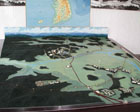
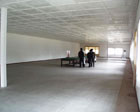

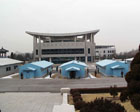
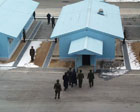
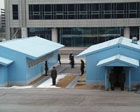
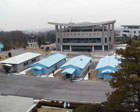
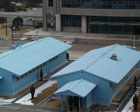 |

May 7, 2002. I spent last weekend in North Korea. It is the last Socialist State and with China turning Capitalist it surely must implode one day soon. It is now turning to tourism from China to raise money. It cost me $US1340 for 5 days airfare included from Hong Kong and was well worth it. But if you go take plenty of food with you. There is almost none in Pyongyang. I had two female guides (one to guard the other from foreign ideas?), a driver and a car.

|
Arirang Mass Games. About 48,000 people with flashcards are each a pixels in the background display. More photos below. |

|
Arirang Mass Games. Another scene to show you how the background changes. Only is a Socialist state could such precise displays be afforded. Some of the displays were breathtaking. |
 |
My two guides who never strayed from my side. I tried to contact them on my trip last month but all I got was a glazed look in the eyes when I asked if it was possible. |

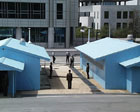


 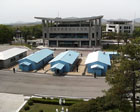
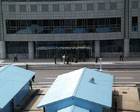 |
Panmunjom. Views into the American side. |
The Arirang Displays were spectacular and breathtaking.


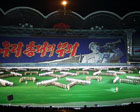
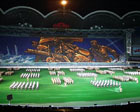



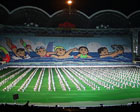
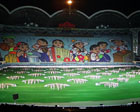
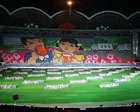 |
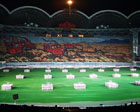
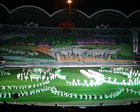
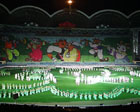
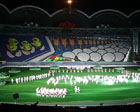
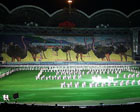
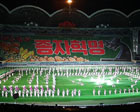


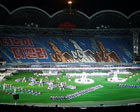
 |

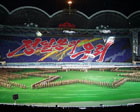
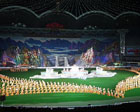
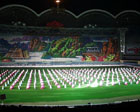

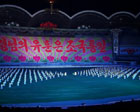


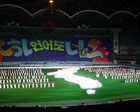
 |
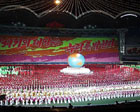

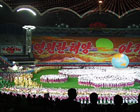
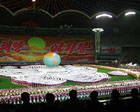 |
The photos are in order. You can see it building up from Army, local scenes, to Reunification and One World peace. The free-fall parachuting (yes!)and bungee jumping were to dark to photograph. |
Kim Il Sung Monument on Mansu Hill and Japanese-Korean students visiting that day.


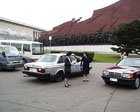
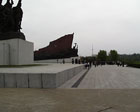
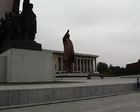
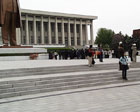


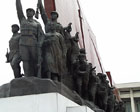
 |
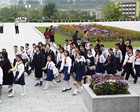
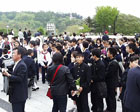

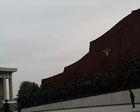
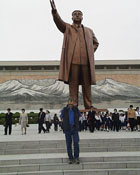
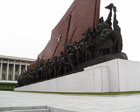
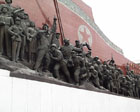

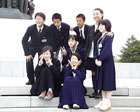
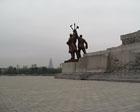 |
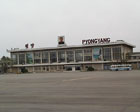 |
Pyongyang airport. |
Note on Restrictions and Immigration Customs Procedures:
Photography. On neither trip were general photographs or video taking restricted in any way with one exception. Only once
were photographs prohibited. At the Mt. Myohyang International Friendship Museums all our cameras had to be deposited at the door
before we could enter. I have no idea why. In general in the streets etc there were no restrictions what-so-ever. At
Aryang we were told video cameras were prohibited but this was clearly because they wanted us to buy their own video casettes
of the Spectacular, nothing to do with any security. In any case many people just went ahead
and made videos under their jackets. The minders having given the warning once made no effort to 'enforce' it.
Airport Immigration. Despite my initial apprehensions, on neither trip were we physically searched or our luggage searched in detail. They did not care less about the newspapers I had (IHT, Time, Wired.) All they asked about were mobile phones. These had to be left at the airport and collected when we left. I did not carry a radio but clearly it would not have been a problem if I had one. They did not look nor ask. They did not Catalog any of the electronic items I had. Luggage was X-rayed and my two battery chargers made me open the case so they could confirm they were just battery chargers. They paid no attention to p/copies in the case about the DPRK nor look at the title of several paperback books. The main interest of the Immigration officials were the returning DPRK citizens from Beijing with TV's, rice cookers, video players, etc. The tourists were just waved by.
Panmunjom. As mentioned the only real warning ever made was 'Not to cross the white line' at Panmunjom. This line goes between the porch of each the huts and can be seen in the photos. One person actually exited the hut not straight out but to the side of the 2 supports and so was behind the white line. The guard visibly jumped and chastised the individual. I could see no real reason for this since as you can see in the photos some of the huts 2 or 3 away from the main tourist-attraction hut simply had no DRPK guards there. An athletic person could have easily run to the ROK side at one of these positions with no DPRK guard in his way nor any behind him to shoot him. Maybe restrictions are greater when DPRK citizens visit the place. Certainly with our group of tourists on both occasions no one was going to 'defect'.
Going off alone. On my first trip; impossible. The two ladies were never more than 10 feet away. On one occasion at the entrance to the subway it seems we went to the wrong subway and the two minders went off to talk to the official. I was all alone in the crowd - but only for about 5 seconds. A man appeared from the crowd, stood next to me and looked to see who was with me. It took all my nagging to get them to take me to a market for the people - which they did eventually.
On my second trip after a doctrinal fight with Mr Kim he paid little attention to me. At the tourist shops he stayed with the other 2 tourists who wanted to buy souvenirs. I just wandered outside, signaled to the driver I was walking (two fingers walking), he nodded a vague assent and off I went for about 10 minutes. I was able to go into the bottom of several apartment blocks and see the local 'shops'. No one paid me any attention.
The Yangdakdo Hotel is on an island in the middle of the Taedong River. It is impossible to walk into Pyongyang from there and there are no taxis. Deviation from the Tour Plan was generally impossible. Trying to get a trolley bus or the subway alone would be out of the question: first one has no money or tokens, and someone would apprehend you for sure. By trying this one would see no more than you could from the windows of the car taking us around. Some children and teenagers made eye contact but adults just looked through you. That any adult would actually try to talk to you was out of the question.
Food. On both occasions I took tuna sandwiches and fruit with me. The food provided on both trips was minimal to say the least even though we were paying for a first class tour. Still people are starving outside so none of us made a point of it. At the last nights dinner on my first trip 3 meat dishes were provided. I soon noticed that neither guide was eating them. They stayed with the rice and kimchee (at least 6 types.) They were not allowed to.
On my second trip the food was better and Mr. Kim tucked into the 'meat' (dog?) fish and chicken along with the rest of us. At Kaesong the 4 of us paid USD15 EACH for a traditional Kaesong chicken dinner. It was completely inedible. The chicken was rubber. Even the soup was somehow off. It was just so embarassing for all concerned: the women looked down, we just wanted to vanish and Mr Kim walked off. We wrote off the money to the experience.
The Minders. Naturally the Minders make a Report about their charges. One should be cautious. However, when one is with these people in a car for hour after hour being told how good the DPRK is one starts to dispute things. In both visits I ended up in shouting matches as one argues back. But they are just saying what they have been told to say. There is no doubt that seeing a steady stream of rich, camera-laden, well dressed Chinese from Singapore, Malaysia and the PRC itself causes these people to think for themselves. On my first visit the Ariyang Spectacular was in full swing. This was not promoted in the 'West' but it was well promoted in Chinese communities abroad. My two women minders understood very well that here was the PRC now full of 'rich' people while they in the DPRK were being left behind.
The arguments of last resort on both my visits were that DPRK citizens cannot travel outside the DPRK, cannot get newspapers and TV from outside the DPRK, that juche was dead because of all the foreign aid and the people in the DPRK have no freedom of speech. The only fact they could dispute was the freedom of speech. So as an example I asked can I go out on the street and say 'Kim Jong Il is the fattest man in the DPRK.' That shut them up. (Actually, I read later that a WFP western worker had been put in jail for 20 days in 2002 sometime before being expelled for saying just that out loud!)
In fact, I wonder why the DPRK allows any tourists at all. By virtue of their clothes, money, cameras, ideas and attitudes they cannot help but show the locals that things are not as bad outside the DPRK as they have been told. But I suppose the DPRK Government just want the money and tolerate the cultural contamination which quite obviously occurs. After all what are a few more people to be send to the Camps.
 |
International Herald Tribune march 25, 2003, cartoon which says it all. Saddam on the couch. |
A Coincidence? Although the visit to the DMZ was relaxed on both visits the inspection of the Museum at the Armistice site within the DMZ was rushed and we were asked to hurry out. Looking back this seems more than a coincidence. Once we had seen the 'axe' I feel we were not wanted to look at the other photos and exhibits. Maybe I am wrong but I mention it so visitors in future can specifically request to spend time in the Museum. Note there is no light in the building so flash photography and a torch are essential.
Third Visit. No rush this time and I got to take photographs and looked at the photos. On the previous visits I think the soldiers in charge just wanted to get back to their base and finish the tour.

Koryo Tours. Beijing place which arranges DPRK tours. The Tour Tips are good but there is one big error; video cameras most definitely ARE allowed. I have taken mine on both trips with not the slightest problem.
My tours were arranged through a Hong Kong travel agent, 'Golden Trip Tranel Service Ltd' tel 2723 0500, speak to Ms. Kit. I had no trouble getting a visa. Unfortunately, the itinerary that is planned for you is rigidly fixed and specific requests to visit particular places (a hospital, a market) were rejected on both my visits.
Unlike many commentators he not only speaks Korean but has been to the DPRK many times. (It amazes me how many Commentators make pronouncements on the DPRK but have never been there.)
The truth is that in most cases, for foreigners, the unpleasantness of North Korea is deduced rather than directly experienced. (Foreigners) are inevitably treated, albeit by otherwise polite and cheerful hosts, as the enemy. Visitors are cocooned, kept at a distance, chaperoned, and lied to. You can meet foreign consultants who talk positively about investment opportunities aid workers who say that officials are doing their best, and experts who think that Kim Jong-il will come up with reforms. But scratch the surface and they all admit the place is vile. (p173)
